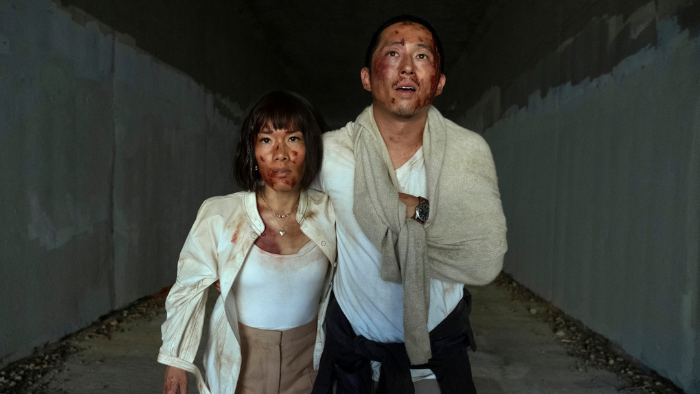President Obama and South Korean President Park Geun-hye take a moment of silence in honor of the Sewol victims. Photo via AP
During President Obama’s visit to South Korea on Friday, as part of his Asia trip, he made several gestures to the country that is still reeling from the loss of hundreds of people from the April 16 Sewolferry sinking.
At a joint press conference with South Korean President Park Geun-hye, he expressed his deepest sympathies to the South Korean people on behalf of America.
“As allies but also as friends, we join you in mourning the lost and the missing, and especially so many young people, students who represented the vitality and the future of this nation,” Obama said. He asked for a moment of silence to honor the lost and missing.
[ad#336]
Obama’s delegation also presented South Korea with a U.S. flag that had been flown over the White House the day the Sewol capsized. The President noted that this follows the American tradition of presenting the flag to the loved ones of lost servicemembers and veterans. “It reflects our deep condolences, but also our solidarity with you during this difficult time, and our great pride in calling you an ally and a friend,” he told President Park.
In addition, Obama mentioned that U.S. protocol officers were presenting a Magnolia tree from the South Lawn of the White House to Danwon High School, where the majority of students and teachers who lost their lives in the ferry sinking went to school. According to White House pool press reports, Magnolia trees have adorned the White House lawn since the mid-1800s, when President Andrew Jackson planted one in honor of his late wife, Rachel. The “Jackson Magnolia” at the White House lawn was shown on the reverse side of the twenty dollar bill from 1928 to 1988.
“These magnolia trees have stood for more than a century and they represent in our country beauty, and with every spring, renewal, the same qualities embodied by all those students,” Obama said.
President Park thanked Obama for his condolences and sympathetic gestures.
“The Korean people draw great strength and courage from your kindness,” Park said.
“Just as the American people were able to rally together in the wake of the September 11 terrorist attacks and were able to prevail over difficult times, so, too, I am sure that Korean people will, in fact, pull through this moment of crisis and be able to achieve the renewal of the Republic of Korea.”
[ad#336]
Here are links to other stories about the Sewol tragedy:
Memorial Message Centers Open in Koreatown
NBC
Two Memorial Message Centers will be open Friday in Koreatown for Los Angeles residents to visit, pay their respects and send messages to the victims of the Sewol Ferry disaster in South Korea.
Hundreds of people, mostly high school students, are feared to have perished in the sinking.
The Centers will remain open through Saturday, May 3 at the following locations. They open at 9 a.m.:
- Korean American Federation of Los Angeles, 981 S. Western Ave., Los Angeles;
- BCM Tofu House, 3580 Wilshire Blvd., Los Angeles.
Culture Blaming and Stereotyping in the South Korean Ferry Tragedy
Time
It’s a story that gets more tragic by the hour. The Sewol ferry, carrying 476 passengers, mostly youth from one high school in Ansan, South Korea, capsized last Wednesday while en route to Jeju Island. Shortly after the sinking, 174 passengers were rescued. More than a week later, at the time of this writing, 175 are confirmed dead; 127 are missing.
It’s also a story that’s downright mystifying. A captain that jumped ship. Untouched lifeboats. Orders to stay put as the vessel rolled. As bodies continue to be pulled from the sea, and as families desperately seek answers, the Sewol disaster has created a cultural flashpoint, forcing many to ask, “Who is to blame?”
Divers battle darkness, fear to find bodies in sunken ferry
USA Today
Divers grope their way slowly through the dark corridors and cabins of the sunken Sewol ferry. Bodies appear suddenly, floating by in the murky water, buoyed by life-jackets or the bloat of decomposition, their faces etched with fear or shock.
Some are still locked together in embraces, a freeze-frame of panic as the water rushed in and the ship sank. The hair of female corpses ripples in the current, framing pale faces.
At times, heavy sediment in the water can make flashlights useless and it is almost total darkness inside the South Korean ferry, which has flipped upside down on the seafloor. Divers must stretch their hands into the void to search for bodies. There’s constant worry their lifeline to the surface, a 100-meter oxygen hose, will get snagged or cut as they swim deeper through the wreck’s maze-like hallways.
[ad#336]
Rescuers paint harrowing portrait of search aboard sunken ferry
CNN
In the final, chaotic moments before the South Korean ferry Sewol rolled over and sank into the chilly waters of the Yellow Sea, 48 girls obeyed the orders of crew members and put on their life vests.
Perhaps afraid, they all crammed into a single room meant for 30.
None of them survived.
The account of the recovery of the girls’ bodies, offered Friday by rescue officials, offers a glimpse of the final moments aboard the sinking ferry, which went down on April 16 with 476 people aboard.
SKOREA: WE MISMATCHED BODIES FROM FERRY DISASTER
Associated Press
As visiting President Barack Obama offered South Koreans his condolences Friday for the ferry disaster, the South Korean government conceded that some bodies have been misidentified and announced changes to prevent such mistakes from happening again.
There have been several reports in South Korean media this week of bodies going to the wrong families, with the error sometimes caught only after the remains were taken to a funeral home. An “action plan” released by the government-wide emergency task force acknowledged that “there have been cases where the victims were wrongly transferred.”
Remains will be transferred to families when there is a match using DNA testing or fingerprint or dental records, the task force said. The transfer will be temporary when a body is matched though identification or physical description, and authorities will wait for more authoritativeevidence before making the transfer permanent.
Korean School Tribute Leaves Empty Spaces For Unfound Ferry Victims
Vos Iz Neias
A floral tribute to the children who drowned in a sinking South Korean ferry features photographs of the victims in their school uniforms and lines of empty spaces waiting to be filled with photos as the confirmed death toll rises.
The pictures, flowers and spaces are banked up the entire wall of a gymnasium near their school on the outskirts of Seoul.
“There are too many pictures, way more than I thought,” said crying university student Jung Sun-a, 24. “And they are too young in these pictures. I really hope they can fulfill their dream in the next life. And I hope the missing kids will also come back to their parents as soon as possible.”











